Training one dog is challenging enough, but what do you do when you have multiple dogs to train at once? While in many cases it’s best to simply separate dogs for training, sometimes it’s much more convenient or even necessary for your goals to train multiple dogs at once.
Today we’re here to help you work towards this tricky goal like a pro!
How to Train Multiple Dogs at Once: Key Takeaways
- It is possible to train two (or more) dogs at the same time. Doing so is more challenging than solo training sessions, but it actually offers unique benefits in some cases.
- Generally, dogs involved in simultaneous training sessions will already need to know some basic skills. They’ll also need to be well-mannered dogs who get along well and have good social skills.
- There are some tools and techniques you can make two-dog training sessions easier. For example, tethers can help keep one dog in place while you teach the other and remote treat dispensers can make it easier to reward them both.
Can You Train Multiple Dogs at Once?
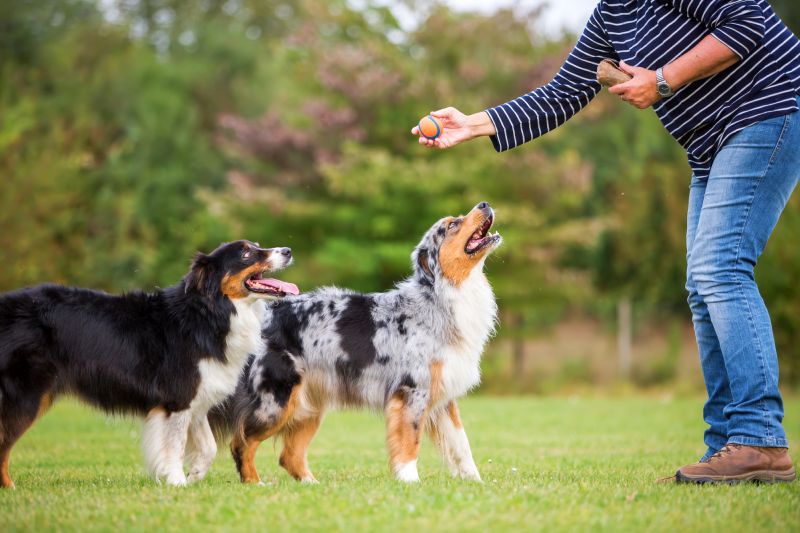
Yes, it’s possible to train multiple dogs at once.
In fact, I often train my dogs at the same time! Allow me to introduce them:
Barley
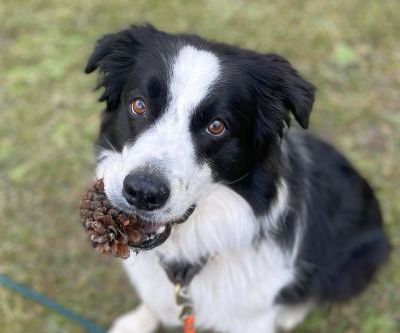
- Age: 9 years old
- Sex: Male
- Breed: Border collie mix
- Hobbies: Trying to convince every single human in the world to play fetch with him, eating trash
- Favorite food: Whatever is in front of him, unless it’s citrus. YUCK!
- Special skills: Finding biological targets for research
Nifler
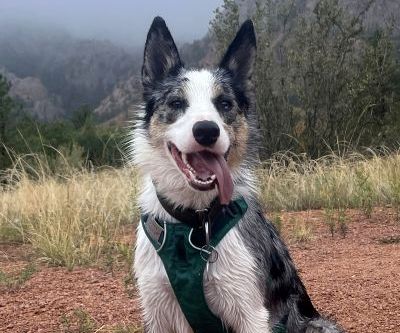
- Age: 2 years old
- Sex: Male
- Breed: Border collie
- Hobbies: Crawling into the laps of small humans, getting mad when you won’t throw the stick deposited 15 feet from your feet
- Favorite food: Chicken nuggets
- Special skills: Running so fast while skijoring that he overheats
For that matter, you’ll occasionally need to train more than one dog at the same time.
For example, whether you’re working on teaching your dogs to relax and settle in public, to pass politely on a trail, or to perform a complex skill in a specific environment, you may find yourself in situations where you simply have to give cues and treats to several dogs at the same time.
However, training more than one dog at a time requires quite a bit of patience and creativity on your part. And before even starting to train two or more dogs at the same time, you’ll need to ensure that all of the dogs have some foundational manners and skills.
What Kinds of Skills Can You Teach Dogs Simultaneously?
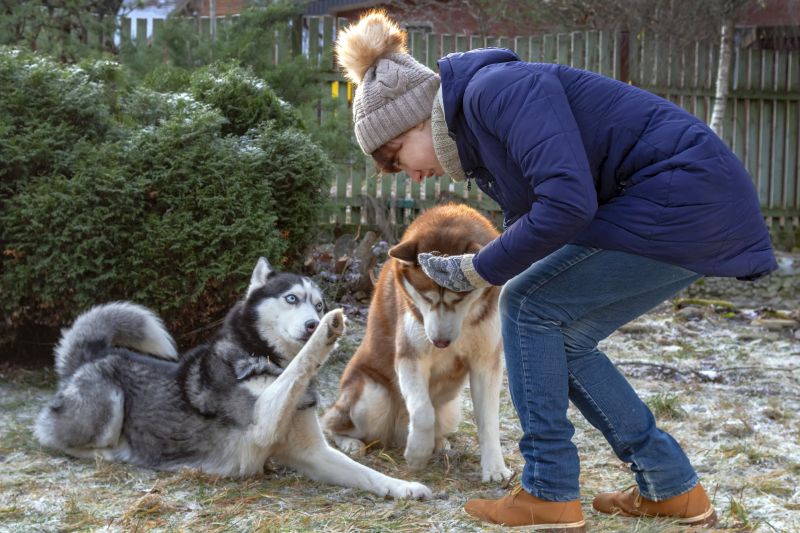
Most of the skills you’d typically work on individually can also be taught in simultaneous fashion. However, some skills work better in simultaneous training sessions than others.
A few of the things that tend to work best for multi-dog training include:
- Wait (especially at doors or to be fed)
- Recall (coming when called)
- Climb on and off raised surfaces
- Politely ignore or pass people, dogs, and cars
- Lie at your feet while you work or relax
Personally, most of my multi-dog training involves:
- Teaching Barley to let Niffler go out the door first
- Teaching both dogs to politely wait while a horse passes on the trail
- Teaching both dogs to patiently wait while I cook
But again, the specific skills you’ll teach your doggos depend on your specific circumstances.
And on the flip side, there are some skills, tricks, and cues that don’t work very well during multi-dog training sessions.
For example, working on high-energy behaviors, skills that involve a lot of movement, and behavior modification should generally be done one-on-one.
Doggo Distinctions: Identifying the Roles of Both Dogs
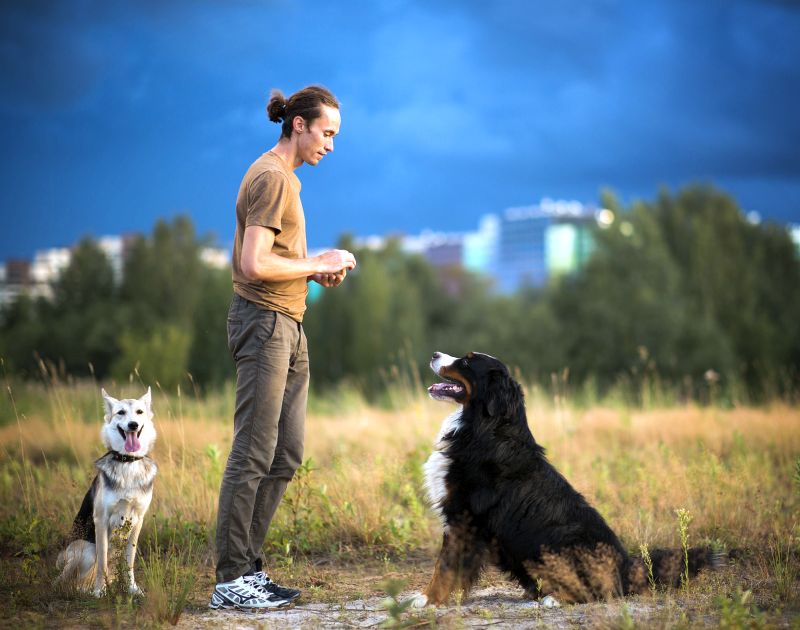
Before moving forward, we need to lay out the language we’ll use to refer to each of your two (or more) dogs.
For the purposes of this article, we’ll separate dogs into either of two roles:
- Trainee: This is the dog that you are actively giving cues and treats to. Typically, you’ll only have one trainee, no matter how many dogs you’re training at a time.
- Standby: This is the dog that is tethered, crated, stationed, or otherwise waiting for more information and treats from you. If you’re training more than two dogs, you may have multiple standby dogs.
Most of the time when you’re training two or more dogs, the standby will be “stationed” somehow. That dog may be in a “stay,” resting in a crate, or tethered to something via a tie-out or leash.
What’s important is that that dog understands that his job is to wait until he’s given another cue, and that he shouldn’t lunge for treats or move to comply with a cue that you’re giving the trainee.
In some cases, you can try giving both dogs cues at the same time.
For example, I sometimes play a game with my two dogs to see which one can sit faster. Both dogs are receiving cues and therefore are both trainees, but the dog that sits faster gets the first treat.
This is a more advanced approach, but you can try it if you like. It’s usually best performed with dogs who’re already relatively well-trained, and you’ll need to be ready to stop and go back to the traditional approach if you’re not getting the results you’d like.
It is also important that both dogs understand not to squabble over treats!
Training Multiple Dogs at Once: A Typical Example
The exact way in which you’ll train your doggo duo will vary based on a million factors, including the current skill level of the dogs, the particular skill or cue you’re trying to teach, the space you have available, and the individual idiosyncrasies of the dogs in question.
But for an easy example, let’s consider teaching both dogs to wait at the door until you release them one at a time. This protocol will likely take you several days, if not a few weeks, to perfect. It’s a tough skill!
In this case, you’d want to:
- Determine the precise spot where each dog will wait at the door. I often use a towel, a mat, or a raised dog bed.
- Train each dog to wait quietly and calmly at the door separately.
- Bring both dogs together for a training session. Simply reward both dogs for staying on their stations near the door – just practice stay!
- Determine which dog is better at waiting (usually the older dog, but not always). That dog will be your standby dog for now.
- Put the standby dog on his station, then bring the trainee dog out. Practice some simple stationary skills with the trainee dog, like sit and down. After each reward for trainee, reward standby as well. Do 5 repetitions before a break, and repeat 5 times. If at any point the standby dog leaves his station, end the session and come back 5 minutes later to make the session a bit easier.
- Swap the trainee and standby dogs and repeat step 6.
- Repeat steps 5 and 6 with slightly more exciting cues (like touch, spin, or speak). Use the same parameters as above.
- Put both dogs on their stations and reward them both heavily for staying in place while you open and close the door.
- Put both dogs on their stations and reward the standby dog heavily as you release the trainee dog from his station with the door closed. Use similar criteria to step 5. Repeat with trainee and standby swapped.
- Repeat step 9 with the door open.
- Repeat step 9, releasing the trainee dog outside and heavily rewarding standby.
- Repeat step 9, releasing trainee and then releasing standby.
This is a simplified protocol, but shows the broad steps taken to train two dogs at once.
The Challenges of Training Several Dogs at Once
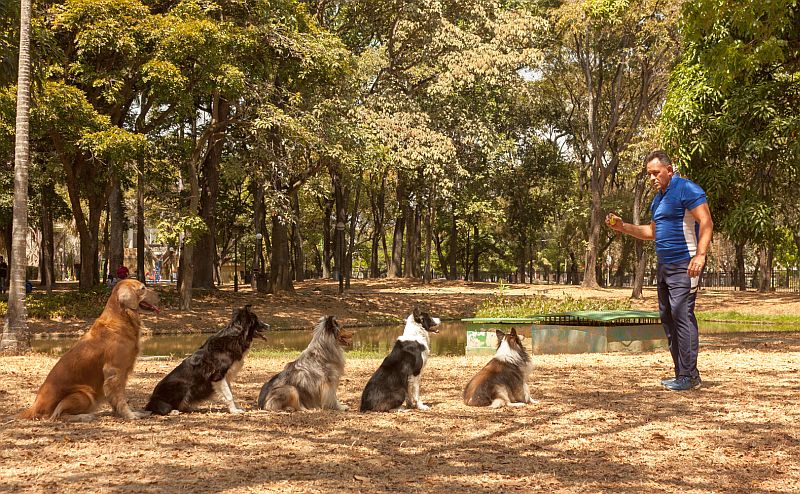
First and foremost, the biggest challenge with training several dogs at once is having adequate patience – and I mean both you and the dogs.
Training multiple dogs at the same time is more challenging than training one dog at a time, so YOU will need to be patient.
And because you can only hand treats to one dog at a time, the standby doggo needs to be patient too! He has to know how to wait without mugging you for treats. Another difficult skill for the standby dog is to wait while you give cues to the trainee. If your dog loves training and wants the treat, he may struggle to simply wait on his mat.
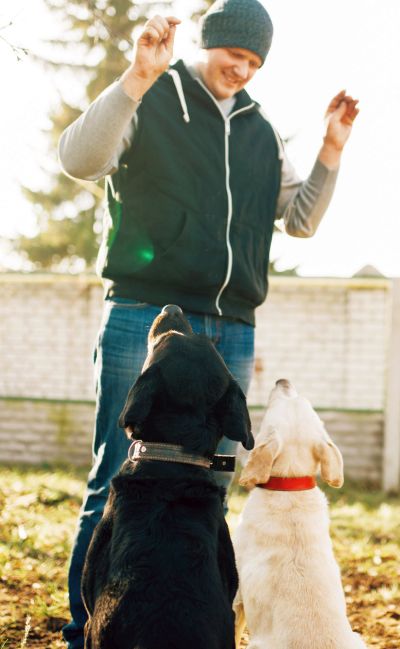
My younger dog Niffler often barks, whines, or even jumps off his stationing area to try and comply with the cues I’m giving Barley, even though he doesn’t want the treats that badly!
All of this is much more difficult if you’re training multiple dogs at once who don’t get along perfectly.
For example, when working on teaching one dog not to bark at, jump on, or resource guard from another dog, you’ll work on the foundations separately.
But eventually you’ll end up training both dogs at once.
The fact that at least one dog has some emotional baggage surrounding the training (and especially treats around other dogs) will make this even more challenging than training multiple dogs to perform simple tricks.
Finally, it’s often challenging for you as a trainer to focus on multiple dogs at once.
As you’re focusing on the trainee dog, you still need to devote some attention to the standby dog to ensure that he’s not getting too distressed, distracted, or excited.
Adjusting your criteria appropriately for both dogs at the same time is an intricate dance.
The Benefits of Training Several Dogs at Once
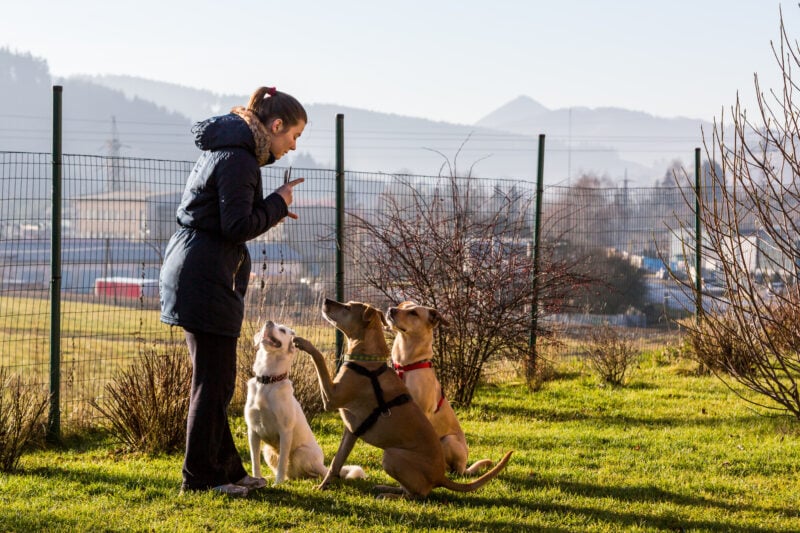
As you can see, there are certainly some challenges involved in training more than one dog at a time. However, there are plenty of benefits to multi-dog training sessions too.
For starters, dogs are also quite social learners and training multiple dogs at once helps you to leverage this.
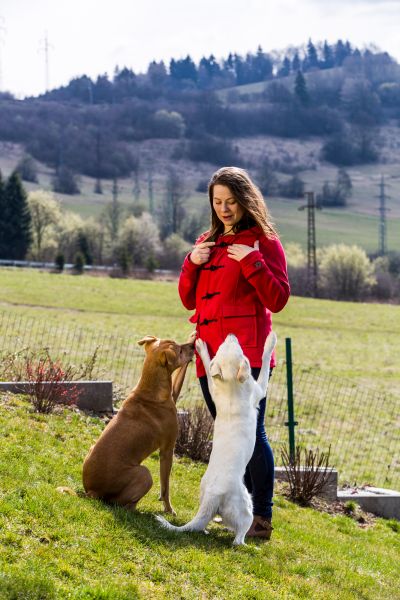
For example, a less experienced dog may learn more quickly by observing a more experienced dog.
When raising my puppy Niffler, I leveraged this phenomenon to help Niffler learn the difference between verbal cues for “sit” and “down.”
With a treat in each hand, I gave the cue and then fed Barley for complying. As soon as Niffler followed suit, he also got a treat.
It was very cute to watch him glance over at Barley for clues before making his guess – and it seemed to help him learn more quickly!
It can also be more convenient to train all of your dogs at once.
Instead of taking one of your dogs to a training space, working on the skills, and then doing the whole thing again with your other dog, you can simply do it all at the same time.
Convenience and the maximization of social learning time are the primary benefits of training dogs at the same time, but simultaneous training also gives you a chance to spend time with both dogs at once. And additional bonding time with your doggos is always a good thing.
Training Multiple Dogs at Once: Tips & Tricks
Again, the exact protocols you use for training multiple dogs will vary based on your goals and needs. However, there are some basic tricks that will help in almost every case!
- Teach Name Recognition: If your dog doesn’t know who you’re talking to, he doesn’t have a chance to wait his turn. Paired with your body language, your dog’s name is the only way he knows who’s being trained. Ensure your dog understands that his name means attention for him, and the other dog’s name means nothing to him at all!
- Work on Basic Obedience Individually: Both dogs should feel comfortable with sit, down, and stay before introducing them to multi-dog training. I like to ensure that my dogs can stay seated or lying down while people, dogs, and other exciting things pass before I expect them to stay put while I’m engaging with another dog.
- Use Leashes/Tie Downs As Necessary: In many cases, it’s smartest to utilize dog crates, elevated training cots, leashes and tie-downs to keep dogs where you want them. This is especially important as a safety measure if the dogs don’t get along, but is also helpful if your dogs aren’t quite perfect at sit-stay yet.
- Teach “Wait Your Turn”: At first, the main goal of your training sessions won’t actually be to train the trainee; it will be to help the standby dog learn to wait. Start by putting both dogs in a sit-stay or on their cots, then work on being able to walk from one to the other giving treats. If your dogs can’t handle being in “standby mode” while you’re just feeding the trainee, he’s not ready for the excitement of you giving the trainee cues and having the trainee move around. From there, start introducing easy cues for the trainee while you reward the standby generously for waiting. Ensure this is going smoothly before expecting to be able to teach the trainee something new! If the standby dog starts to whine, bark, or leave his station, you’ve pushed too hard. It’s probably time to end the session, because putting the standby dog back and rewarding him for staying has the potential to create a pattern!
- Don’t Play Favorites: It’s important to ensure that both dogs get turns as the trainee. Almost more important, however, is to reward the standby doggo for his work. Be generous and consistent with your rewards while ensuring that you’re always paying the dogs for behavior that you want more of.
- Enlist Some Help: Training multiple dogs at once is much easier if you’ve got multiple trainers! Even if you’re just asking a family member or roommate to feed the standby dog food every 5 seconds, it’s extraordinarily helpful to have additional hands.
- Consider Using Technology: It’s hard to beat a Treat-and-Train if you want an easy way to reward one dog from a distance while you’re focusing on another dog. You can even set the Treat-and-Train to dispense treats to the standby dog on an automatic basis.
How to Train Multiple Dogs at Once: FAQ
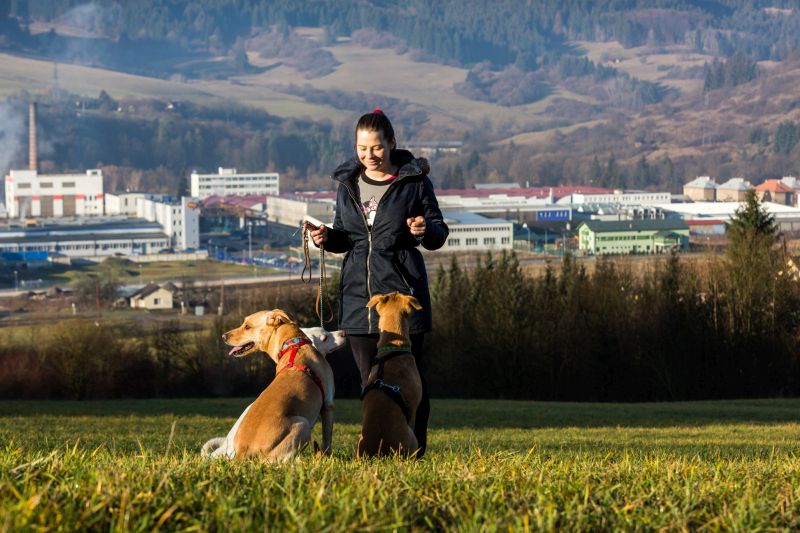
Training multiple dogs at the same time can be a lot to get your head around. But we’ll try to answer some of the most common questions owners have to help!
How do I train multiple dogs at once?
Ensure each dog knows his name and how to wait in one place, then gradually introduce the concept of waiting while you engage with another dog. With patience and generosity, you can help multiple dogs learn valuable skills at the same time.
Is it possible to train multiple dogs?
Yes, it is possible to train multiple dogs at once. However, it’s usually best to ensure that the dogs each understand their basic task before introducing the challenge of completing that task around peers.
Is it better to train dogs separately or together?
Generally, it’s best to teach each dog skills separately. It’s challenging to focus on two learners at the same time, and many dogs struggle with waiting patiently as their buddy gets fed treats. However, sometimes it’s necessary or convenient to train dogs together.
Training multiple dogs at once can be a great way to meet your training goals. With a few foundational skills, it doesn’t have to be incredibly difficult to get more mileage out of your training.
Let us know in the comments below how training is going for you and your pack!
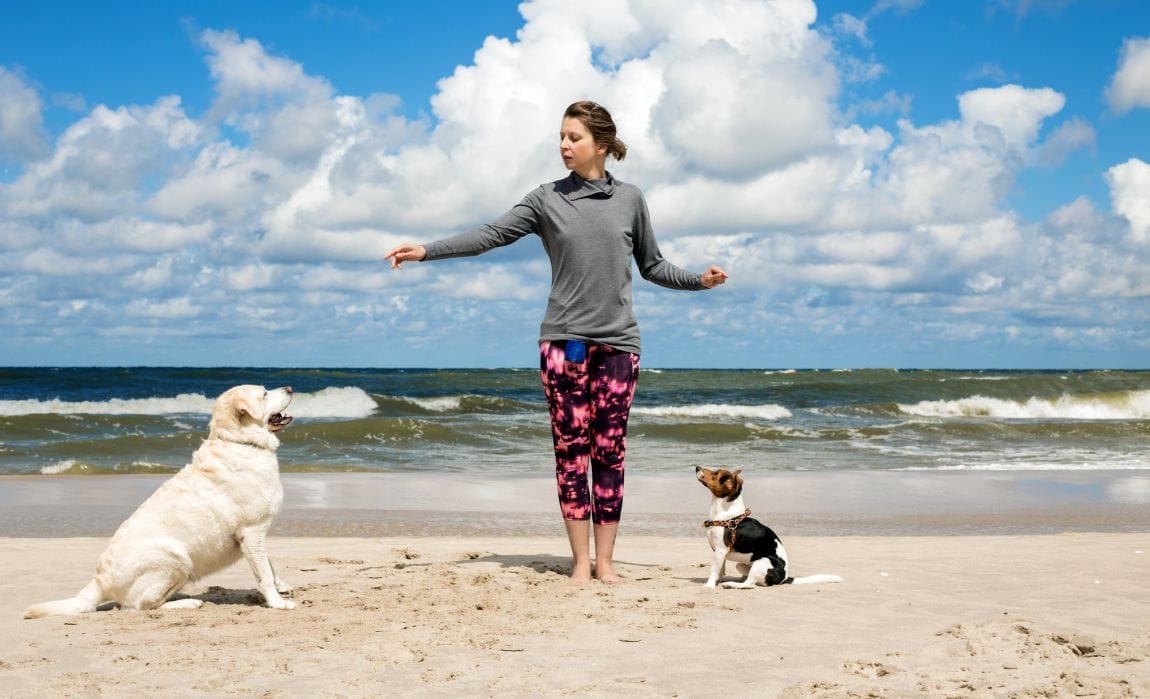

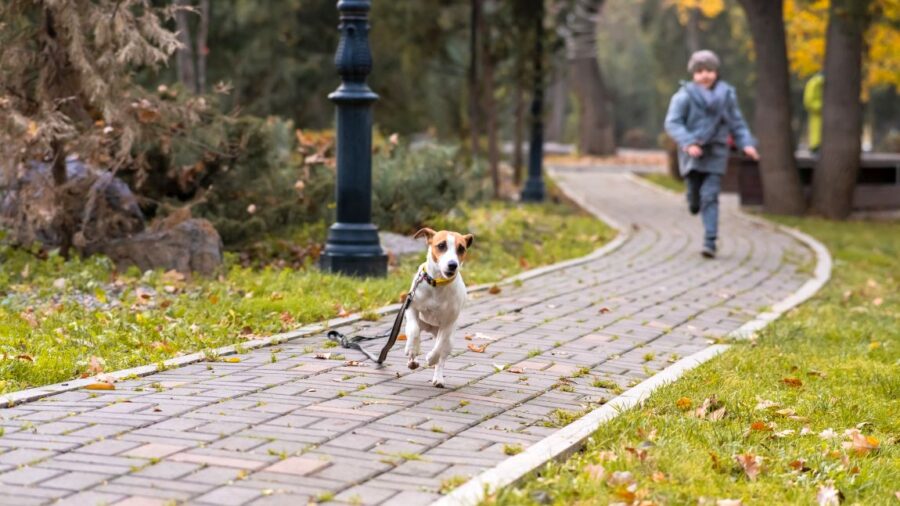


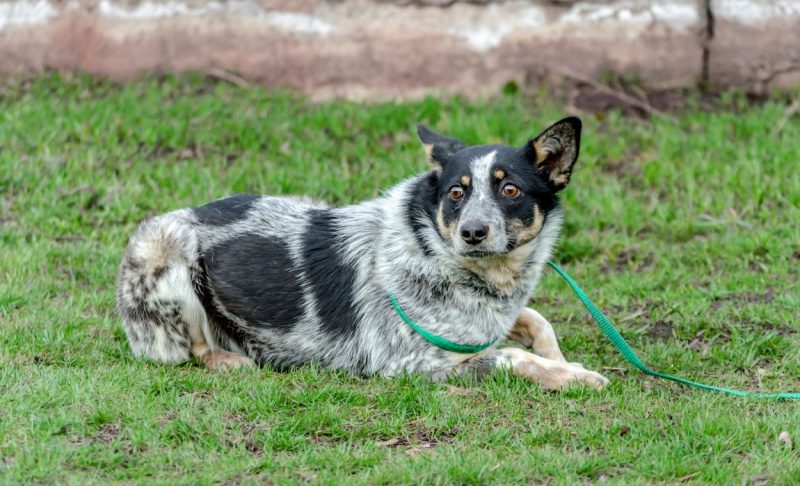
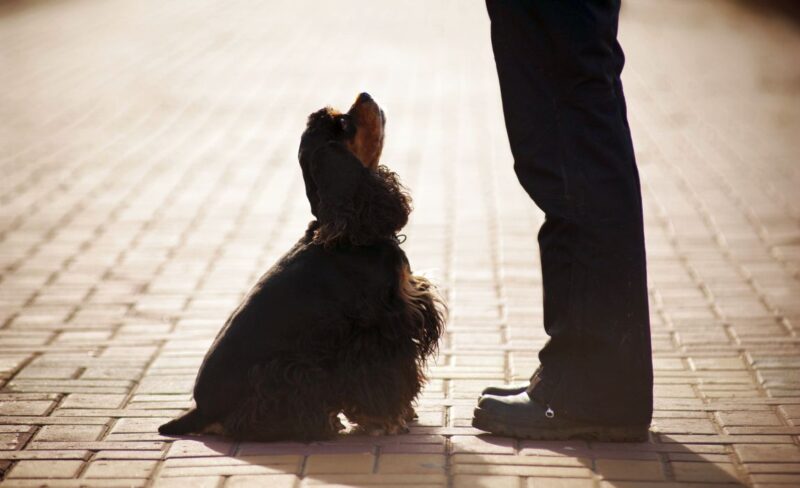
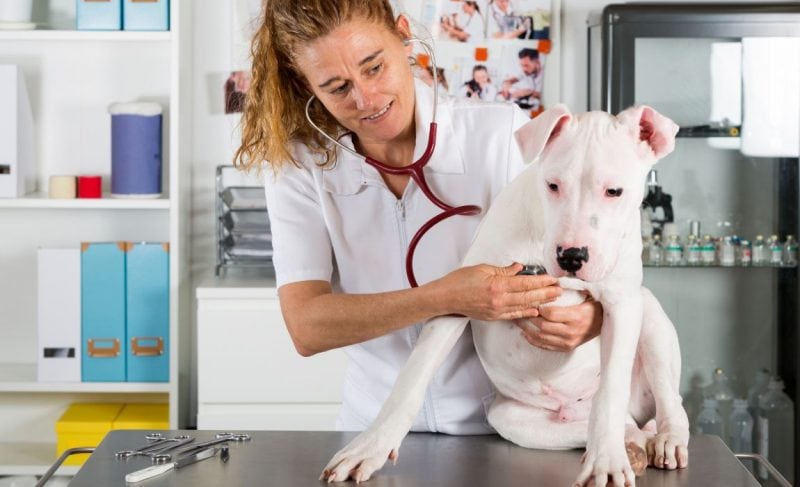
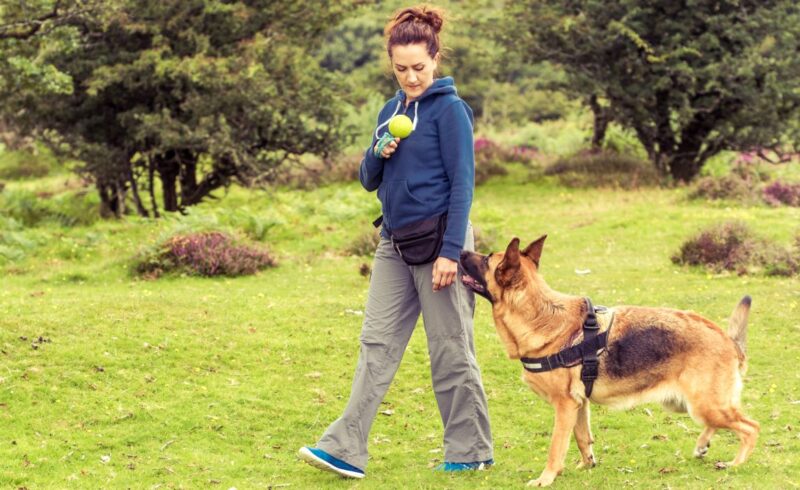
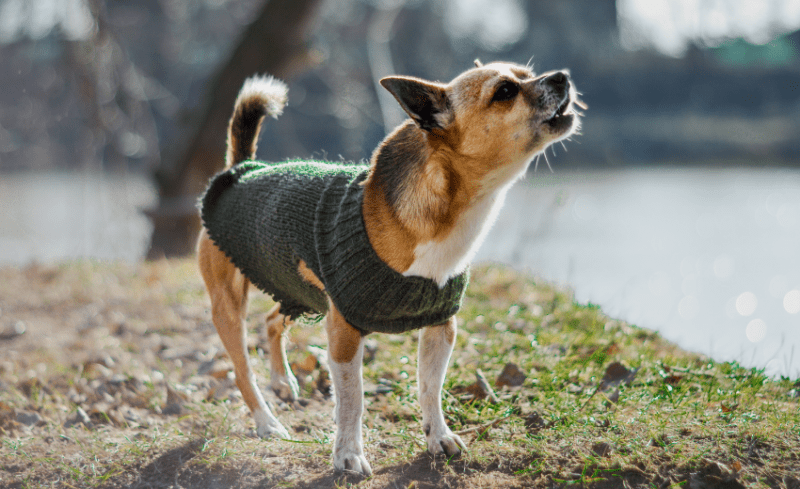
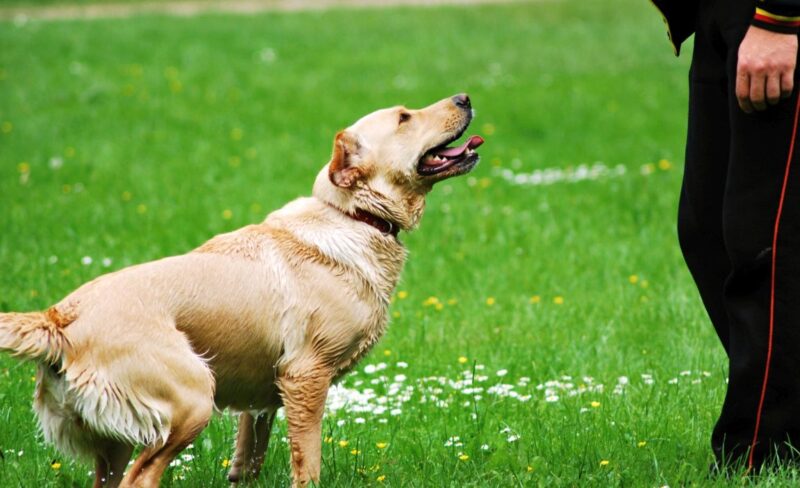

Leave a Comment